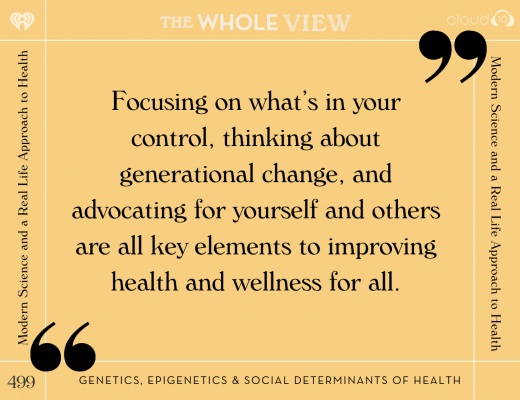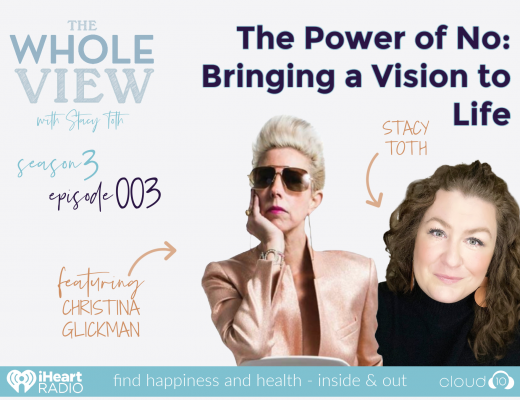Welcome Sarah Ballantyne back to the Whole View! This week, Stacy and Sarah dive into the science behind mid life crises, why they occur, and what we can do about them.
Find Sarah:
- thepaleomom.com
- nutrivore.com
- drsarahballantyne on FB, IG, Pinterest and TikTok
- https://www.thepaleomom.com/product-category/live-events/
If you enjoy the show, please leave a review. Letting people know on iTunes or however you listen that it’s worth their time could change someone’s life!
Key Takeaways
Introductions
- For many of us, this time period of our life also coincided with huge cultural change: a global pandemic and life at home has caused a rise in those seeking therapy. All that considered, Stacy prefers to think of her own mid-life re-evaluation the way the Atlantic refers to as “transcendence.” “With knowledge and effort, you (and I) can make two crucial choices that can lead to harnessing the changes and difficulties of aging to instead design a midlife transcendence.”
- She’s fascinated by the psychology research on this because psychologist don’t actually agree on how to define it a midlife crisis. Some don’t even think it exists, although interestingly, economists can measure midlife crises in our purchasing habits, making it very hard to study.
- Internally-driven behavioral maladaptation and/or mental health challenge in response to social isolation compounding the lowest ebb of happiness and wellbeing in adulthood
- Making big changes in midlife to address dissatisfaction in life does not automatically mean it’s a crisis. The crisis part is the mental health / existential aspect (e.g., depression) or behavioral maladaptation (dopamine seeking behavior like alcohol or drug abuse, adrenaline seeking behavior like driving recklessly, and/or making huge life choices that aren’t actually compatible with your values, like leaving your family.
What Are Mid Life Crises
- When stringent criteria is applied, about 10% of people are have a midlife crisis (But, self-identifying, more like ¼ of us, but because we tend to apply the term midlife crisis to any challenge that happens in those decades, including externally-driven)
- In fact, twice as many adults (age 30-80) see mid life as a time full of new possibilities than see it negatively. So, there’s ways to navigate the feelings that could lead to a midlife crisis in a healthy way that actually increases your wellbeing.
- Choose to focus on what age gives you, not what it has taken away… Stagnation, which can lead to a crisis, happens when you try to fight against time, whether you’re desperately trying not to look older or struggling against changes in your skills and strengths.
- Choose subtraction, not addition. – or as we called in in Ep 3 with Christina Glickman – the power of no. Studies find that the most common concerns reported by middle-aged adults involve getting everything done in their busy life, their energy level, job complications, and insufficient sleep.
The Science Behind Mid Life Crises
- Those of us in mid-life have the complication of what psychologists have called “sandwiching”: As you raise your kids, you are also saddled with the care of aging parents. According to findings from the 1995 National Survey of Families and Households, about 40 percent of people in their early 40s have both parents alive; about 80 percent of people in their late 60s have no parents alive.
- During the intervening years, adults spend an average of 2.5 hours a day in unpaid care of a family member. The burden of caregiving can be even more overwhelming for those with little time or limited financial resources.
- The good news is that “people tend to get happier, more creative, less neurotic, more agreeable, and more conscientious. On average, research suggests that people get steadily psychologically healthier after 30, and well into old age.”
- The aging brain is less prone to regret, so we align our expectations with reality Some studies show a U-shaped of wellbeing with the dip of the U in middle age, but more show that wellbeing simply steadily increases as we age!
- None of that explains how research has found that “animals’ sense of well-being bottoms out in their late 20s to mid-30s, the ape equivalent of middle age, before rebounding in old age.”
Topics discussed
- The finding that mid life crises may not be uniquely human suggests that the events might have a biological, rather than a sociological, cause.
- “Among three different groups of chimps and orangutans surveyed, the happiest tended to be the oldest and youngest, and the most dissatisfied tended to be in their 30s.”
- “Maybe evolution needed us to be at our most dissatisfied in mid life,” as unhappiness can be a catalyst for change, potentially spurring unhappy adults to act more adaptively.”
- One thing worth mentioning is that the evaluation of mid life crises in primates was made by zookeepers. So there is a chance of anthropomorphizing here although they tried to control for that in the study.
- Sarah recaps: https://www.nature.com/articles/s42003-021-02206-x
- This study showed that normal changes in our brains as we age affect our social behavior, and identified social isolation as the primary determinant of whether someone has a midlife crisis
- Explains why mid life crises are common in men due to differences between males. And females in social networks/encounters sue to changes in socialization between younger adulthood and middle adulthood. Women on average are more likely to maintain social connections even in middle age
- When Stacy thinks about her own re-evaluation and possible mid life crises over the past few years, she can think of very dark times. But she also sees positive change it spurred, such as:
- Why she decided to foster, leading to expanding her family
- Personal growth with learning and unlearning more about society and culture that she realized she didn’t need to participate in if she didn’t want to
- Gave up on hard pants and heels – athleisure and sustainable sneakers all day everyday!
Want More? Have Questions?
Want more? Come join the Patreon community! You can support The Whole View podcast and hear what Stacy and her guests really think about the topic in this week’s exclusive and uncensored behind-the-scenes bonus audio. We love connecting with our Patrons! It’s a direct line to submit your questions for upcoming shows. You also get access to some additional cool features like Q&As, voting on show topics and guests, and a quarterly exclusive commercial-free episode.
Sources
- nature.com/articles/s42003-021-02206-x
- nature.com/articles/nature.2012.11847
- theatlantic.com/family/archive/2022/05/midlife-crisis-choices-opportunities/638427/
- apa.org/pubs/journals/releases/pag152351.pdf
- realeverything.com/the-whole-view-season-3-ep-03-the-power-of-no-bringing-a-vision-to-life-with-christina-glickman/
Products & Sponsors
- justthrivehealth.com/discount/thewholeview
- Save 15% sitewide with promo code: THEWHOLEVIEW
- Dameproducts.com
- use code WHOLEVIEW for 15% off sitewide
- Beautycounter.com/stacytoth
Want more info on our Real Life? Healthy recipes, parenting tips, and general lifestyle stuff goes out in our Real Everything newsletter, join here.
Never want to miss a post, sale, or deal? Join my Healthy Inside & Out e-mail list for more info on non-toxic living and safer skincare!
Note: Stacy and her guests are not medical professionals. This podcast is for general educational purposes and NOT intended to diagnose, advise, or treat any physical or mental illness. We always recommend you consult a licensed service provider.




